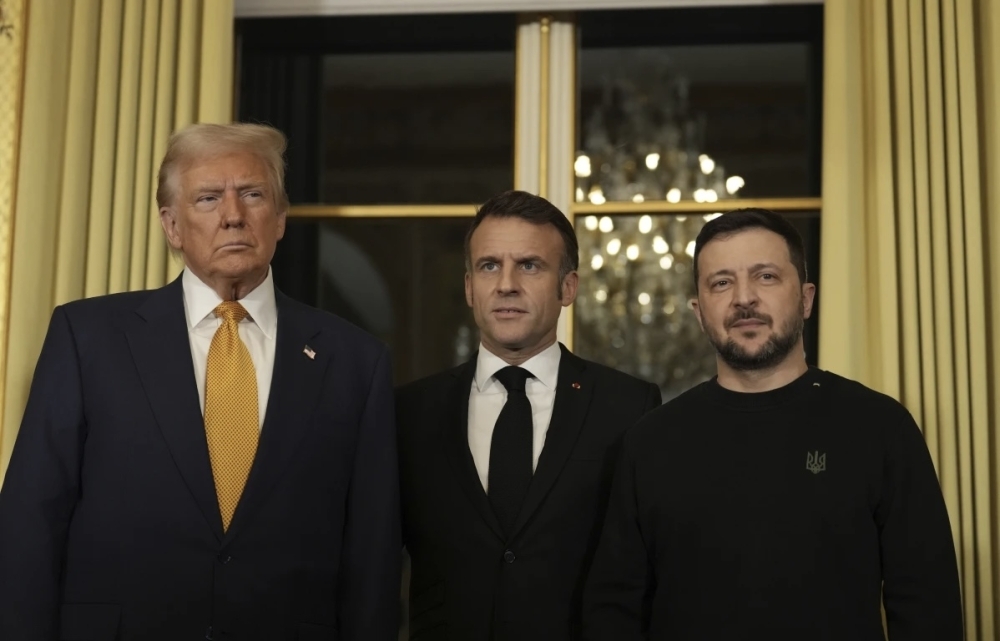Peace Talks in Ukraine: A Critical Analysis
Recently, a meeting took place in Paris between leaders from France and Ukraine, where they expressed Kiev’s desire to reach an agreement to end the ongoing war that has lasted for over a thousand days. Shortly after the meeting, US President-elect Donald Trump called for an immediate ceasefire in Ukraine. In a post on his platform “Truth Social,” Trump claimed that both Moscow and Kiev had lost hundreds of thousands of soldiers in a war that “should never have started.” He emphasized the need for an immediate ceasefire and the start of negotiations, highlighting the unnecessary loss of lives and destruction of families.
Trump’s statements came after a meeting with Ukrainian President Volodymyr Zelensky and French President Emmanuel Macron, which Zelensky later described as “constructive.” In a later press conference, Zelensky insisted that any peace agreement must be “fair” to Ukrainians, ensuring that there is no opportunity for Russia, Putin, or any other aggressors to return. He provided updates on the significant human losses Ukraine has suffered since Moscow’s invasion on February 24, 2022, citing the deaths of 43,000 soldiers and injuries to 370,000 others.
Both Russia and Ukraine have been hesitant to disclose official casualty numbers, but Western officials have indicated that the recent months of intense warfare in eastern Ukraine have resulted in record losses for both sides, with tens of thousands killed and wounded each month.
Earlier, NATO Secretary-General Jens Stoltenberg led a new campaign to urge European countries to increase defense spending, a shortfall in the budget that Trump used to criticize US allies during his first term, damaging trust. After Russia annexed the Ukrainian peninsula of Crimea a decade ago, NATO leaders agreed to halt defense cuts that began after the end of the Cold War and move towards spending 2% of their gross domestic product on military budgets. Since Russia launched its full-scale invasion nearly three years ago, leaders agreed that the 2% target should be the minimum, not the maximum defense spending. On average, US allies collectively meet this target, but about a third of members still struggle to meet it individually.
Trump, who will assume office on January 20, has threatened not to defend “delinquent” countries. NATO operates on the principle that an attack on any member should be considered an attack on all members. Trump’s remarks have undermined confidence in relying on the United States in crises. Stoltenberg, after chairing a meeting of NATO foreign ministers in Brussels, stated, “If you want to keep deterrence at the current level, 2% is not enough. We can now defend ourselves and no one should try to attack us. But I want this to remain the case after 4 or 5 years.”
Meeting of Leaders:
A meeting between former US President Donald Trump, Ukrainian President Volodymyr Zelensky, and French President Emmanuel Macron.
Zelensky’s Stance:
Zelensky emphasized that any peace agreement must be “fair” to Ukraine to prevent the return of Russia or future aggressors.
Ukraine’s Losses:
Zelensky announced the loss of 43,000 soldiers and the injury of 370,000 since the Russian invasion in February 2022.
Losses on Both Sides:
Western officials confirmed record human losses for both sides in the recent months of intense warfare in eastern Ukraine, with tens of thousands killed and wounded monthly.
Hesitancy in Declaring Numbers:
Both Russia and Ukraine have refrained from releasing precise official numbers of casualties.
Conclusion:
In conclusion, the peace talks in Ukraine highlight the urgent need for a fair and lasting agreement to end the devastating war. The international community must come together to support Ukraine and ensure that any resolution prioritizes the well-being of its people and prevents future conflicts.
FAQs
1. What was the purpose of the meeting in Paris?
The meeting aimed to discuss peace negotiations and the ongoing conflict in Ukraine.
2. How did Zelensky describe the meeting?
Zelensky referred to the meeting as “constructive” and emphasized the importance of a fair peace agreement.
3. What were the casualties reported by Zelensky?
Zelensky announced the loss of 43,000 soldiers and the injury of 370,000 since the Russian invasion in February 2022.
4. Why have Russia and Ukraine been hesitant to disclose casualty numbers?
Both countries have been cautious in releasing official numbers to control the narrative and avoid undermining morale.
5. What did NATO leaders agree on regarding defense spending?
NATO leaders agreed that spending 2% of GDP on defense should be the minimum target for member countries.
6. How has Trump’s stance on defense affected NATO’s unity?
Trump’s criticism of NATO allies’ defense spending has strained trust within the alliance and raised concerns about US commitment.
7. What is the principle NATO operates on regarding member defense?
NATO operates on the principle that an attack on one member should be considered an attack on all members.
8. What is the significance of Stoltenberg’s statement on defense spending?
Stoltenberg emphasized the need for adequate defense spending to ensure long-term deterrence and protection for member states.
9. How can the international community support Ukraine in the peace process?
The international community can provide diplomatic support, humanitarian aid, and mediation efforts to facilitate a peaceful resolution in Ukraine.
10. What are the broader implications of the peace talks in Ukraine?
The peace talks in Ukraine have implications for regional stability, international relations, and the future of conflict resolution efforts.
Tags:
Peace Talks, Ukraine, Donald Trump, Zelensky, Macron, NATO, Russia, Conflict, Defense Spending

